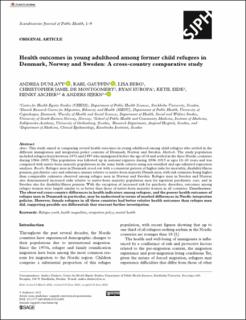| dc.contributor.author | Dunlavy, Andrea | |
| dc.contributor.author | Gauffin, Karl | |
| dc.contributor.author | Berg, Lisa | |
| dc.contributor.author | de Montgomery, Christopher Jamil | |
| dc.contributor.author | Europa, Ryan Tamayo | |
| dc.contributor.author | Eide, Ketil | |
| dc.contributor.author | Ascher, Henry | |
| dc.contributor.author | Hjern, Anders | |
| dc.date.accessioned | 2022-03-16T11:47:43Z | |
| dc.date.available | 2022-03-16T11:47:43Z | |
| dc.date.created | 2022-02-24T13:02:18Z | |
| dc.date.issued | 2021 | |
| dc.identifier.citation | Dunlavy, A., Gauffin, K., Berg, L., De Montgomery, C. J., Europa, R., Eide, K., Ascher, H. & Hjern, A. (2021). Health outcomes in young adulthood among former child refugees in Denmark, Norway and Sweden: A cross-country comparative study. Scandinavian Journal of Public Health, 1-9. | en_US |
| dc.identifier.issn | 1403-4948 | |
| dc.identifier.uri | https://hdl.handle.net/11250/2985514 | |
| dc.description.abstract | Aims: This study aimed at comparing several health outcomes in young adulthood among child refugees who settled in the different immigration and integration policy contexts of Denmark, Norway and Sweden.
Methods: The study population included refugees born between 1972 and 1997 who immigrated before the age of 18 and settled in the three Nordic countries during 1986–2005. This population was followed up in national registers during 2006–2015 at ages 18–43 years and was compared with native-born majority populations in the same birth cohorts using sex-stratified and age-adjusted regression analyses.
Results: Refugee men in Denmark stood out with a consistent pattern of higher risks for mortality, disability/illness pension, psychiatric care and substance misuse relative to native-born majority Danish men, with risk estimates being higher than comparable estimates observed among refugee men in Norway and Sweden. Refugee men in Sweden and Norway also demonstrated increased risks relative to native-born majority population men for inpatient psychiatric care, and in Sweden also for disability/illness pension. With the exception of increased risk for psychotic disorders, outcomes among refugee women were largely similar to or better than those of native-born majority women in all countries.
Conclusions: The observed cross-country differences in health indicators among refugees, and the poorer health outcomes of refugee men in Denmark in particular, may be understood in terms of marked differences in Nordic integration policies. However, female refugees in all three countries had better relative health outcomes than refugee men did, suggesting possible sex differentials that warrant further investigation. | en_US |
| dc.language.iso | eng | en_US |
| dc.rights | Navngivelse 4.0 Internasjonal | * |
| dc.rights.uri | http://creativecommons.org/licenses/by/4.0/deed.no | * |
| dc.title | Health outcomes in young adulthood among former child refugees in Denmark, Norway and Sweden: A cross-country comparative study | en_US |
| dc.type | Peer reviewed | en_US |
| dc.type | Journal article | en_US |
| dc.description.version | publishedVersion | en_US |
| dc.rights.holder | © Author(s) 2021. | en_US |
| dc.source.pagenumber | 1-9 | en_US |
| dc.source.journal | Scandinavian Journal of Public Health | en_US |
| dc.identifier.doi | https://doi.org/10.1177/14034948211031408 | |
| dc.identifier.cristin | 2005145 | |
| cristin.ispublished | true | |
| cristin.fulltext | postprint | |
| cristin.qualitycode | 1 | |

